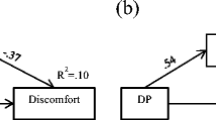Abstract
Increasing university students’ engagement with ethics is becoming a prominent call to action for higher education institutions, particularly professional schools like business and engineering. This paper provides an examination of student attitudes regarding ethics and their perceptions of ethics coverage in the curriculum at one institution. A particular focus is the comparison between results in the business college, which has incorporated ethics in the curriculum and has been involved in ethics education for a longer period, with the engineering college, which is in the nascent stages of developing ethics education in its courses. Results show that student attitudes and perceptions are related to the curriculum. In addition, results indicate that it might be useful for engineering faculty to use business faculty as resources in the development of their ethics curricula.
Similar content being viewed by others
References
AACSB International. (2004). Ethics education in business schools: Report of the ethics education task force to AACSB international’s board of directors AACSB. Tampa FL. Available at http://www.aacsb.edu/publications/researchreports/archives/ethics-education.pdf.
American Association of Colleges and Universities (AAC&U). (2010). Shared futures: Global learning and social responsibility. Retrieved from http://www.aacu.org/SharedFutures/global_century/institutions.cfm.
Barry, B. E., & Ohland, M. W. (2009). Applied ethics in the engineering, health, business, and law professions: A comparison. Journal of Engineering Education, 100, 377–388.
Bebeau, M. (2002). The defining issues test and the four component model: Contributions to professional education. Journal of Moral Education, 31, 271–295.
Cavico, F. J., & Mujtaba, B. G. (2009). The state of business schools, business education, and business ethics. Journal of Academic and Business Ethics, 2(1), 1–7.
Colby, A., & Sulliman, W. M. (2008). Ethics teaching in undergraduate engineering education. Journal of Engineering Education, 97(3), 327–338.
Culver, S. M., Puri, I. K., Spinelli, G., DePauw, K. P., & Dooley, J. E. (2011). Collaborative dual-degree programs and value added for students: Lessons learned through the EVALUATE-E project. Journal of Studies in International Education, 1028315311403934.
Desplaces, D. E., Melchar, D. E., Beauvais, L. L., & Bosco, S. M. (2007). The impact of business education on moral judgment competence: An empirical study. Journal of Business Ethics, 74, 73–87.
Felicio, D. M., & Pieniadz, J. (1999). Ethics in higher education: Red flags and grey areas. Feminism & Psychology, 9(1), 53–73.
Gordon, R., & Howell, J. (1959). Higher education for business. New York: Columbia University Press.
Hashemian, G., & Loui, M. C. (2010). Can instruction in engineering ethics change students’ feelings about professional responsibility? Science and Engineering Ethics, 16, 201–215.
Herkert, J. R. (2000). Engineering education in the USA: Content, pedagogy, and curriculum. European Journal of Engineering Education, 25(4), 303–313.
Herkert, J. R. (2002). Continuing and emerging issues in engineering education. The Bridge, 32, 8–13.
Joseph, J., Berry, K., & Deshpande, S. P. (2010). Factors that impact the ethical behavior of college students. Contemporary Issues in Education Research, 3(5), 27–34.
Karns, G. L. (2005). An update of marketing student perceptions of learning activities: Structure, preferences and effectiveness. Journal of Higher Education, 27(2), 1630171.
Kohlberg, L. (1969). Stage and sequence: The cognitive developmental approach to socialization. In D. Goslin (Ed.), Handbook of socialization theory (pp. 347–480). Chicago: Rand McNally.
Kuhn, K., & Rundle-Thiele, S. R. (2009). Curriculum alignment: Exploring student perception of learning achievement measures. International Journal of Teaching and Learning in Higher Education, 21(3), 351–361.
Lau, C. L. L. (2010). A step forward: Ethics education matters! Journal of Business Ethics, 92, 565–584.
Loe, T. W., & Weeks, W. A. (2000). An experimental investigation of efforts to improve sales students’ moral reasoning. Journal of Personal Selling and Sales Management, 20, 243–251.
Loui, M. C. (2005). Ethics and the development of professional identities of engineering students. Journal of Engineering Education, 94, 383–390.
Neubaum, D. O., Pagell, M., Drexler, J. A., Jr., McKee-Ryan, F. M., & Larson, E. (2009). Business education and its relationship to student personal moral philosophies and attitudes toward profits: An empirical response critics. Academy of Management Learning and Education, 8(1), 9–24.
Nguyen, N. T., Basuray, M. T., Smith, W. P., Kopka, D., & McCulloh, D. N. (2008). Ethics perception: Does teaching make a difference? Journal of Education for Business, 84(2), 66–75.
Payne, D. (2003, April). Engineering ethics and business ethics: Commodities for a comprehensive code of ethics. IEEE Region 5, 2003 annual technical conference (pp. 81–87).
Pierson, F. C. (1959). The education of american businessmen: A study of university-college programs in business administration. New York: McGraw-Hill.
Reidenbach, R. E., & Robin, D. P. (1995). A response to “on measuring ethical judgments”. Journal of Business Ethics, 14, 159–162.
Rest, J. R. (1986). Moral development: Advances in research and theory. New York: Praeger.
Rossouw, G. J. (2002). Three approaches to teaching business ethics. Teaching Business Ethics, 6(4), 411–433.
Schurr, G. (1982). Toward a code of ethics for academicians. The Journal of Higher Education, 53, 318–354.
Sims, R. R., & Felton, E. L., Jr. (2006). Designing and delivering business ethics teaching and learning. Journal of Business Ethics, 63, 297–312.
Swanson, D. L., & Frederick, W. C. (2003). Turning Point: Are business schools silent partners in corporate crime?. Journal of Corporate Citizenship, 9, 24–27.
Winkleman, P. (2006). Integrating open-ended design in a science and mathematics based engineering engineering program. Avaiable at: http://cden2006.utoronto.ca/data/10057.pdf. Accessed 28 March 2010.
Acknowledgments
This material is based upon work supported by the National Science Foundation under Grant No. (NSF/EESE#0832852). Any opinions, findings, and conclusions or recommendations expressed in this material are those of the author(s) and do not necessarily reflect the views of the National Science Foundation.
Author information
Authors and Affiliations
Corresponding author
Rights and permissions
About this article
Cite this article
Culver, S.M., Puri, I.K., Wokutch, R.E. et al. Comparison of Engagement with Ethics Between an Engineering and a Business Program. Sci Eng Ethics 19, 585–597 (2013). https://doi.org/10.1007/s11948-011-9346-3
Received:
Accepted:
Published:
Issue Date:
DOI: https://doi.org/10.1007/s11948-011-9346-3




